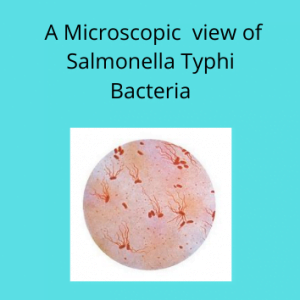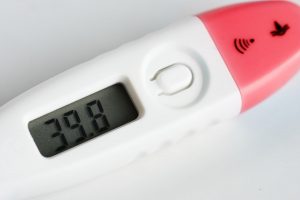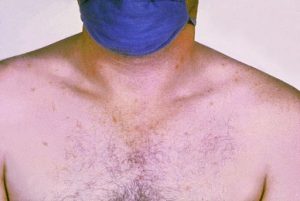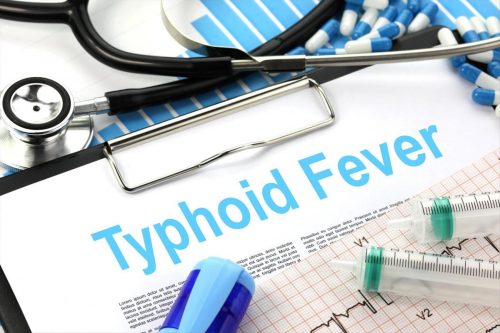How to diagnose, treat and prevent Typhoid Fever
Introduction-
Typhoid Fever is a disease caused by a bacteria called Salmonella typhi and Para typhi, through the fecal-oral route.
Why I am writing this article on Typhoid fever?
As monsoon has commenced in almost all parts of India, so has different diseases and illnesses that occur due to rains. There are many patients visiting my clinic at this time of year who have a high fever. My previous 3 articles were on fever during monsoon, namely-
Why I am writing this article on a dreaded disease called Typhoid Fever because it occurs mostly during the monsoon.
Now, what exactly is Typhoid Fever?
Typhoid fever, as mentioned in the introduction, is a fever caused by bacteria called Salmonella Typhi[see the image given below]

These organisms are transmitted through the food we eat, especially street food.
They are found mostly in drains carrying sewage water. It is also called the‘ food handler’s’ disease. The food handler is termed the carrier. Carriers have the following features-
- He or she may or may not have a fever.
- The patient may be asymptomatic.
- Secondly, he or she may not be maintaining good sanitary hygiene like washing hands with soap after attending nature’s call.
- These carriers are mostly cooks who work in hotels and restaurant or a waiter or waitress who deliver drinking water. Avoid drinking water from hotels if you see the waiter dipping his hands in the glasses which he serves [this is common in rural India].
Typhoid Mary
There is a famous story about the discovery of typhoid which led to a lady cook called Mary Mallon in America, who was later called Typhoid Mary.

She, as a carrier, seems to have infected at least fifty-one people out of which 3 people died due to typhoid. You can read all about Typhoid Mary on Wikipedia or Google.
You can also read a novel written by Mary Beth Keane called FEVER. It escribes in detail how typhoid spread in America during the early 1900s.
How is typhoid related to monsoon?
During monsoon, a lot of common houseflies are seen which, after scavenging through sewage dumps, carry the bacteria on their legs and transmit it to the food we eat by settling on it while we eat. So, here the common housefly is the carrier. These flies are seen mostly hovering in hoards around the street food vendors and mostly settle on uncovered cooked food.

Common signs and symptoms of the disease: –
Typhoid fever is a disease of the intestinal tract. After ingesting contaminated food, the bacteria makes its way through the stomach and reaches the small intestine. Then it lodges there and grows in the lymphatic tissue of the intestines called the Peyer’s patches.
It is important to note that Salmonella typhi is resistant to acid present in the stomach unlike other bacterial species.
So those of you who are on medicine to control acidity like omeprazole, pantoprazole, etc. are more prone or at risk to get typhoid than others. The other common cause in developing countries is the consumption of shellfish which acts as a carrier. Because shellfish are mostly found in water that is contaminated by sewage water.
The incubation period i.e. the time interval between getting infected to having signs and symptoms of typhoid fever is about 10 to 14 days.
Signs and Symptoms of Typhoid Fever-
People suffering from typhoid present with the following signs and symptoms:-
1] Fever-

–
The fever keeps on rising steadily till it reaches a plateau. After this phase, the fever remains steady above 38° Celsius[C]. This fever starts subsiding 48 hours after starting the typhoid medication. In some cases, it can reach even above 40°C.
2] Headache
Mild to severe headache is very common and can be very disturbing.
3] Constipation or diarrhea-
These patients have loose motions, often called“ pea-soup” diarrhea along with abdominal pain;
4] Bloating-
There is a fullness of stomach with loss of appetite and feeling of nausea sometimes leading to vomiting.
5] Severe Debility-
The patient may have extreme weakness and prostration with an apathetic-lethargic state[the so-called tuphos by the ancient Greeks].
6] Rash over Chest/Abdomen-
Pink colored or Rose spots rash appear in fair-skinned patients, often seen on the chest, abdomen, arms, and legs in up to 25% of the patients late in the first week of fever, as shown below. You can zoom out for seeing how the rash appears.

7] Pain in abdomen-
There is the tenderness of the abdomen i.e. pain on feeling the abdomen by hands. It may be due to-
- the enlargement of the liver[termed hepatomegaly]
- an organ called spleen [felt by palpation with hands by a physician] also termed hepatosplenomegaly.
8]Delirium-
Some patients may present with very high fever and delirium or psychosis. Delirium is a condition where the patient is semi-conscious and incoherent in his speech. Psychosis in typhoid is a condition where the patient becomes violent because of the effect of high fever on the brain. These patients have serious problems and the have to be hospitalized.
9] Oral cavity-
Coated tongue [as shown below] with loss of taste and appetite is very common.
9] Bradycardia-
Bradycardia is a presence low pulse rate compared to high pulse rate found mostly in other high fever states. This is also called relative bradycardia.
10] Melena
Black colored stools- also called melena– occurs in patients if there is an intestinal perforation, which is a serious complication of typhoid fever.
What are the investigations which your family physician may order if he is suspecting typhoid fever?
Your family physician or healthcare provider may suggest you some or all of these tests for arriving at a proper diagnosis.
A] Complete blood check up[CBC]-
There is a lowering of total white blood cell count[WBC], with a gross reduction of lymphocytes. This is termed relative lymphopenia. The overall WBC reduction is called Leucopenia. The normal WBC range is 4000-10000/dl of blood. In typhoid fever, it may go as low as 1500.
B] Blood culture and Sensitivity test–
This is the most important and sensitive test to diagnose Typhoid fever.
A blood sample of the patient is taken and spread in a glass dish called Petri dish. This contains appropriate media with antibiotic patches, which can grow bacteria.
If the blood contains Salmonella bacteria, then it will form colonies around these antibiotic patches. The antibiotic patch around which the growth of bacteria is least is then chosen to administer to the patient. It is the most effective one which will inhibit or kill the bacteria.
C] Stool culture:-
This test is similar to blood culture, the only difference being that stool is used in place of blood. As the disease is primarily of the intestines, the bacteria if present, will be excreted in huge quantities through stools. This can be grown in culture media as shown above for blood.
D] Widal test–
This was a test to detect the H and O antigen of Salmonella bacteria which is present in the blood. It is being carried out in some hospitals but has become outdated as of today. Of late, it has been replaced by more specific tests like the antigen-antibody tests like the ELISA[enzyme-linked immunosorbent assay] to detect the IgM and IgG antibodies to the Salmonella cell wall components. The values of both these antibodies are high in a patient of typhoid.
E] Liver function test [LFT] –
Two tests, namely serum alanine aminotransferase [ALT] and lactic dehydrogenase[LDH] are elevated in typhoid as the severity of infection increases. The ratio of the two i.e. ALT: LDH, if it is more than 9:1 indicates Viral Hepatitis.
If it is less than 9:1 it indicates Typhoid Fever Hepatitis.
F] Other tests
Sometimes, other sophisticated tests like a polymer chain reaction test [PCR] is rarely used if the cause of fever is not known by using the above 5 tests.
Treatment of Typhoid Fever-
We now come to the treatment part of the disease. If the illness is uncomplicated, it can be treated on an outpatient basis and if complicated, the patient should be hospitalized. Having said this, what are the precautions one should take if you are having typhoid?
Precautions
They are:-
1] Wash your hands thoroughly after defecation using a good disinfectant soap like Dettol.
2] The patient should not cook food for others.
3] Have plenty of fluids, especially boiled and cooled water.
4] Eat soft digestible non-spicy food which does not cause distension or bloating of the abdomen.
5] Total bed rest with least exertion is advised till full recovery, which is almost 2 weeks from being diagnosed as typhoid positive.
Medications:–
1] Paracetamol [ Crocin, Calpol, Pacimol] to control the temperature.
2] Antibiotics like
- Chloromycetin- this was the only medicine available when typhoid was first detected many years ago. Of late, the use of this medicine has been curtailed.
- Ampicillin+trimethoprim-sulphamethoxazole combination [typhoid bacteria has been found resistant to these medicines nowadays],
- Fluoroquinilones like ciprofloxacin, ofloxacin
- ceftriaxone+ ciprofloxacin combination.
- newer medicines combination like cefpodoxime and ofloxacin are showing encouraging results.
3] Probiotics like lactobacillus, Saccharomyces Boulardi is also prescribed along with vitamins as the beneficial bacterias also perish while treating typhoid fever.
These medicines are to be taken for 10 to 14 days, depending upon the severity of typhoid fever.
A word of caution-
As far as treatment with antibiotics is concerned, one should not self-medicate and leave it to your respective health care provider/physician.
You can procure these medicines at a discounted rate by uploading a doctor’s prescription by clicking these links-
Is there a vaccine for Typhoid fever?
Yes, there is. These vaccines provide passive immunity and protect one from getting infected. I will mention a few names here.
- Typbar TCV Vaccine;
- Biovac Typhoid 25mcg Injection;
- Typhivax 0.25 mcg Injection
To have these vaccines, kindly consult your family physician or doctor.
Conclusion
In conclusion, I would like to advise everybody
- to take maximum precautions during the rainy season;
- and to avoid eating food from street vendors who do not cover cooked food.
Thankfully or fortunately, because of the COVID 19 pandemic lockdown, the street vendors have disappeared[for fear of COVID 19 infection]. The hotels are not operating fully- only home delivery of food is allowed. So we are partially protected.
But, but- there is no lockdown for the vermin like the house fly and those in contaminated water.
Further reading-
If you have found this article useful, I request you share it among your friends and groups on social media so that that one remains hale and hearty in the rainy season. Alternately, you can click to tweet below-
Typhoid Fever-How to Diagnose, Treat and Prevent It Share on X

